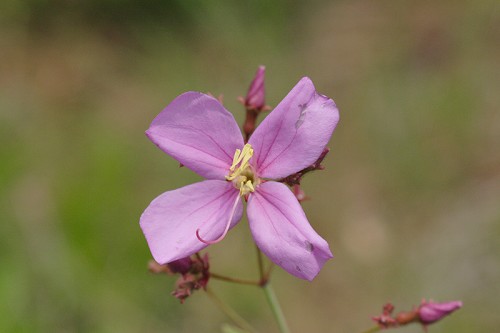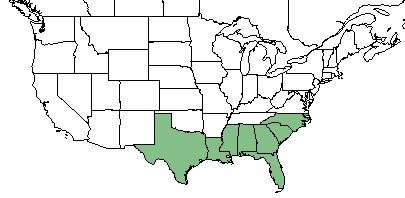Difference between revisions of "Rhexia alifanus"
(→Ecology) |
HaleighJoM (talk | contribs) (→Ecology) |
||
| (19 intermediate revisions by 7 users not shown) | |||
| Line 23: | Line 23: | ||
==Description== | ==Description== | ||
| − | ''R. alifanus'' is a perennial forb/herb of the Melastomataceae family that is native to North America. <ref name= "USDA"> [https://plants.usda.gov/core/profile?symbol=CEAM USDA Plant Database]</ref> | + | ''R. alifanus'' is a perennial forb/herb of the Melastomataceae family that is native to North America.<ref name= "USDA"> [https://plants.usda.gov/core/profile?symbol=CEAM USDA Plant Database]</ref> |
<!-- Basic life history facts such as annual/perrenial, monoecious/dioecious, root morphology, seed type, etc. --> | <!-- Basic life history facts such as annual/perrenial, monoecious/dioecious, root morphology, seed type, etc. --> | ||
==Distribution== | ==Distribution== | ||
| − | ''R. alifanus'' is found in the southeastern United States; specifically in Florida, Georgia, South Carolina, North Carolina, Alabama, Louisiana, Mississippi, and Texas. <ref name= "USDA"> [https://plants.usda.gov/core/profile?symbol=CEAM USDA Plant Database]</ref> | + | ''R. alifanus'' is found in the southeastern United States; specifically in Florida, Georgia, South Carolina, North Carolina, Alabama, Louisiana, Mississippi, and Texas.<ref name= "USDA"> [https://plants.usda.gov/core/profile?symbol=CEAM USDA Plant Database]</ref> |
==Ecology== | ==Ecology== | ||
| − | ===Habitat=== | + | ===Habitat===<!--Natural communities, human disturbed habitats, topography, hydrology, soils, light, fire regime requirements for removal of competition, etc.--> |
| − | ''R. alifanus'' is typically found in pine flatwoods, savannas, and pocosin borders.<ref name= "Weakley"> Weakley, A. S. (2015). Flora of the Southern and Mid-Atlantic States. Chapel Hill, NC, University of North Carolina Herbarium.</ref> | + | ''R. alifanus'' is typically found in pine flatwoods, savannas, longleaf pine-scrub oak ridges, pine woodlands, hillside bogs, cypress ponds, and pocosin borders.<ref name= "Weakley"> Weakley, A. S. (2015). Flora of the Southern and Mid-Atlantic States. Chapel Hill, NC, University of North Carolina Herbarium.</ref><ref name="FSU"> Florida State University Herbarium Database. URL: http://herbarium.bio.fsu.edu. Last accessed: June 2021. Collectors: R. R. Bounds, Edwin L. Bridges, Robert K. Godfrey, C. W. James, Robert Kral, Jason Larkin, S. W. Leonard, Steve L. Orzell, and D. B. Ward. States and counties: Florida: Baker, Franklin, Jackson, Leon, Liberty, and Wakulla. Georgia: Laurens.</ref> It is also found in disturbed areas including road banks, drained and bulldozed flatwoods bogs, logged pinelands, and burned longleaf pine savanna.<ref name="FSU"/> Transitions between uplands and lowlands, commonly wet prairie, is another common habitat to find ''R. alifanus''.<ref name= "Crandall"> [Crandall, R. M. and W. J. Platt (2012). "Habitat and fire heterogeneity explain the co-occurrence of congeneric resprouter and reseeder Hypericum spp. along a Florida pine savanna ecoline." Plant Ecology 213: 1643-1654.]</ref> |
| + | |||
| + | Associated species: ''Pinus palustris, Muhlenbergia capillaris, Paspalum plicatulum, Xyris spp., Pluchea rosea, Rhexia lutea, Liatris spp., Dichanthelium spp.'', and ''Asclepias''.<ref name="LSU">Louisiana State University, Shirley C. Tucker Herbarium accessed using Southeastern Regional Network of Expertise and Collections (SERNEC) data portal. URL: http://sernecportal.org/portal/collections/index.php Last accessed: June 2021. Collectors: Charles M. Allen and David J. Rosen. States and Counties: Louisiana: Calcasieu.</ref> | ||
| + | |||
| + | ''R. alifanus'' was unaffected by clearcutting and chopping in north Florida flatwoods forests.<ref>Moore, W.H., B.F. Swindel, and W.S. Terry. (1982). Vegetative Response to Clearcutting and Chopping in a North Florida Flatwoods Forest. Journal of Range Management 35(2):214-218.</ref> | ||
| + | |||
| + | ''Rhexia alifanus'' is frequent and abundant in the Upper Panhandle Savannas and Panhandle Seepage Savannas community type. It is an indicator species for the Lower Panhandle Savannas community type as described in Carr et al. (2010).<ref>Carr, S.C., K.M. Robertson, and R.K. Peet. 2010. A vegetation classification of fire-dependent pinelands of Florida. Castanea 75:153-189.</ref> | ||
| + | |||
| + | ===Phenology===<!--Timing off flowering, fruiting, seed dispersal, and environmental triggers. Cite PanFlora website if appropriate: http://www.gilnelson.com/PanFlora/ --> | ||
| + | ''R. alifanus'' has been observed flowering May through July.<ref name= "Pan Flora"> Nelson, G. PanFlora: Plant data for the eastern United States with emphasis on the Southeastern Coastal Plains, Florida, and the Florida Panhandle. www.gilnelson.com/PanFlora/ Accessed: 29 MAY 2018</ref> | ||
| − | |||
| − | |||
| − | |||
| − | |||
| − | |||
===Seed dispersal=== | ===Seed dispersal=== | ||
| − | This species is thought to be dispersed by gravity. <ref> Kirkman, L. Katherine. Unpublished database of seed dispersal mode of plants found in Coastal Plain longleaf pine-grasslands of the Jones Ecological Research Center, Georgia.</ref> | + | This species is thought to be dispersed by gravity.<ref> Kirkman, L. Katherine. Unpublished database of seed dispersal mode of plants found in Coastal Plain longleaf pine-grasslands of the Jones Ecological Research Center, Georgia.</ref> |
<!--===Seed bank and germination===--> | <!--===Seed bank and germination===--> | ||
| − | + | ||
| + | ===Fire ecology=== <!--Fire tolerance, fire dependence, adaptive fire responses--> | ||
| + | Populations of ''Rhexia alifanus'' have been known to persist through repeated annual burning.<ref>Platt, W.J., R. Carter, G. Nelson, W. Baker, S. Hermann, J. Kane, L. Anderson, M. Smith, K. Robertson. 2021. Unpublished species list of Wade Tract old-growth longleaf pine savanna, Thomasville, Georgia.</ref> | ||
| + | |||
===Pollination=== | ===Pollination=== | ||
| − | Bees are pollinators for ''R. alifanus''. <ref name= "Singer"> [Pitts-Singer, T. L., et al. (2002). "Insect pollinators of three rare plants in a Florida longleaf pine forest." Florida Entomologist 85(2): 308-316.]</ref> | + | Bees are pollinators for ''R. alifanus''.<ref name= "Singer"> [Pitts-Singer, T. L., et al. (2002). "Insect pollinators of three rare plants in a Florida longleaf pine forest." Florida Entomologist 85(2): 308-316.]</ref> |
| − | <!--=== | + | <!--===Herbivory and toxicology===<!--Common herbivores, granivory, insect hosting, poisonous chemicals, allelopathy, etc--> |
| − | <!--==Diseases and parasites==--> | + | <!--===Diseases and parasites===--> |
| + | |||
| + | ==Conservation, cultivation, and restoration== | ||
| − | == | + | ==Cultural use== |
| + | It is possible the greens and tubers can be used in salads for a sweetish, nutty taste.<ref> Fernald, et al. 1958. Edible Plants of Eastern North America. Harper and Row Publishers, New York.</ref> | ||
| − | |||
==Photo Gallery== | ==Photo Gallery== | ||
<gallery widths=180px> | <gallery widths=180px> | ||
</gallery> | </gallery> | ||
==References and notes== | ==References and notes== | ||
Latest revision as of 15:01, 15 July 2022
| Rhexia alifanus | |
|---|---|

| |
| Photo by John Gwaltney hosted at Southeastern Flora.com | |
| Scientific classification | |
| Kingdom: | Plantae |
| Division: | Magnoliophyta - Flowering plants |
| Class: | Magnoliopsida - Dicots |
| Order: | Myrtales |
| Family: | Melastomataceae |
| Genus: | Rhexia |
| Species: | R. alifanus |
| Binomial name | |
| Rhexia alifanus Walter | |

| |
| Natural range of Rhexia alifanus from USDA NRCS Plants Database. | |
Contents
Taxonomic Notes
Synonym: none
Variety: none
Description
R. alifanus is a perennial forb/herb of the Melastomataceae family that is native to North America.[1]
Distribution
R. alifanus is found in the southeastern United States; specifically in Florida, Georgia, South Carolina, North Carolina, Alabama, Louisiana, Mississippi, and Texas.[1]
Ecology
Habitat
R. alifanus is typically found in pine flatwoods, savannas, longleaf pine-scrub oak ridges, pine woodlands, hillside bogs, cypress ponds, and pocosin borders.[2][3] It is also found in disturbed areas including road banks, drained and bulldozed flatwoods bogs, logged pinelands, and burned longleaf pine savanna.[3] Transitions between uplands and lowlands, commonly wet prairie, is another common habitat to find R. alifanus.[4]
Associated species: Pinus palustris, Muhlenbergia capillaris, Paspalum plicatulum, Xyris spp., Pluchea rosea, Rhexia lutea, Liatris spp., Dichanthelium spp., and Asclepias.[5]
R. alifanus was unaffected by clearcutting and chopping in north Florida flatwoods forests.[6]
Rhexia alifanus is frequent and abundant in the Upper Panhandle Savannas and Panhandle Seepage Savannas community type. It is an indicator species for the Lower Panhandle Savannas community type as described in Carr et al. (2010).[7]
Phenology
R. alifanus has been observed flowering May through July.[8]
Seed dispersal
This species is thought to be dispersed by gravity.[9]
Fire ecology
Populations of Rhexia alifanus have been known to persist through repeated annual burning.[10]
Pollination
Bees are pollinators for R. alifanus.[11]
Conservation, cultivation, and restoration
Cultural use
It is possible the greens and tubers can be used in salads for a sweetish, nutty taste.[12]
Photo Gallery
References and notes
- ↑ 1.0 1.1 USDA Plant Database
- ↑ Weakley, A. S. (2015). Flora of the Southern and Mid-Atlantic States. Chapel Hill, NC, University of North Carolina Herbarium.
- ↑ 3.0 3.1 Florida State University Herbarium Database. URL: http://herbarium.bio.fsu.edu. Last accessed: June 2021. Collectors: R. R. Bounds, Edwin L. Bridges, Robert K. Godfrey, C. W. James, Robert Kral, Jason Larkin, S. W. Leonard, Steve L. Orzell, and D. B. Ward. States and counties: Florida: Baker, Franklin, Jackson, Leon, Liberty, and Wakulla. Georgia: Laurens.
- ↑ [Crandall, R. M. and W. J. Platt (2012). "Habitat and fire heterogeneity explain the co-occurrence of congeneric resprouter and reseeder Hypericum spp. along a Florida pine savanna ecoline." Plant Ecology 213: 1643-1654.]
- ↑ Louisiana State University, Shirley C. Tucker Herbarium accessed using Southeastern Regional Network of Expertise and Collections (SERNEC) data portal. URL: http://sernecportal.org/portal/collections/index.php Last accessed: June 2021. Collectors: Charles M. Allen and David J. Rosen. States and Counties: Louisiana: Calcasieu.
- ↑ Moore, W.H., B.F. Swindel, and W.S. Terry. (1982). Vegetative Response to Clearcutting and Chopping in a North Florida Flatwoods Forest. Journal of Range Management 35(2):214-218.
- ↑ Carr, S.C., K.M. Robertson, and R.K. Peet. 2010. A vegetation classification of fire-dependent pinelands of Florida. Castanea 75:153-189.
- ↑ Nelson, G. PanFlora: Plant data for the eastern United States with emphasis on the Southeastern Coastal Plains, Florida, and the Florida Panhandle. www.gilnelson.com/PanFlora/ Accessed: 29 MAY 2018
- ↑ Kirkman, L. Katherine. Unpublished database of seed dispersal mode of plants found in Coastal Plain longleaf pine-grasslands of the Jones Ecological Research Center, Georgia.
- ↑ Platt, W.J., R. Carter, G. Nelson, W. Baker, S. Hermann, J. Kane, L. Anderson, M. Smith, K. Robertson. 2021. Unpublished species list of Wade Tract old-growth longleaf pine savanna, Thomasville, Georgia.
- ↑ [Pitts-Singer, T. L., et al. (2002). "Insect pollinators of three rare plants in a Florida longleaf pine forest." Florida Entomologist 85(2): 308-316.]
- ↑ Fernald, et al. 1958. Edible Plants of Eastern North America. Harper and Row Publishers, New York.